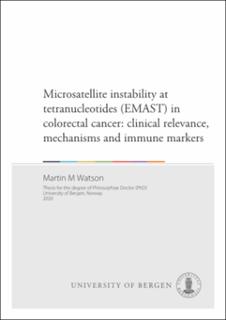| dc.contributor.author | Watson, Martin M | en_US |
| dc.date.accessioned | 2020-06-05T11:21:33Z | |
| dc.date.available | 2020-06-05T11:21:33Z | |
| dc.date.issued | 2020-06-18 | |
| dc.date.submitted | 2020-05-15T09:16:07.949Z | |
| dc.identifier | container/41/1f/c3/5b/411fc35b-40b6-4656-b2a0-22aac7ca1ccf | |
| dc.identifier.isbn | 9788230859704 | en_US |
| dc.identifier.isbn | 9788230849965 | en_US |
| dc.identifier.uri | https://hdl.handle.net/1956/22471 | |
| dc.description.abstract | Colorectal cancer (CRC) is the second-leading cause of cancer-related death and a global burden in terms of incidence, person-years of life lost and public health costs. About 10-20% of sporadic CRCs develop through a pattern of DNA mismatch repair (MMR) insufficiency that leads to hypermutation, microsatellite instability (MSI) and a strong immunogenicity, exemplified by the higher number of immune cells infiltrating the tumours. Over the course of the past two decades, MSI was investigated and defined in the context of CRC and other solid tumours. MSI can be measured by length variation at selected mononucleotide repeats across the normal/tumour genomes, with specific panels and thresholds, and/or by immunohistochemical (IHC) analysis of MMR members such as MSH2 and MLH1. MSI CRCs are often located in the proximal colon, have better prognosis, and are to some degree refractory to a common CRC chemotherapy (5-fluorouracil). Further, MSI CRCs are better responders to anti-PD-1/PD-L1 immunotherapy, which is an exciting development in modern oncology. A variation of MSI, investigated exclusively at tetranucleotides, is elevated microsatellite alterations at selected tetranucleotides (EMAST). Studies on EMAST in CRC are scarce, no consensus on a panel of markers and their cut-off exists, and neither its clinicopathological implications nor its relationship with MSI is defined at present. In this work, EMAST was investigated in a highly selected archival cohort of non-metastatic CRC and associated with MSI, proximal colon location and a lower number of lymph nodes harvested at surgery (paper I). Loss of MSH3 has been proposed in the literature as a possible mechanism leading to instability at tetranucleotides, and therefore implicated with EMAST in CRC. To test this hypothesis, automated digital image analysis of IHC staining for MSH3 was performed in a consecutive cohort of CRC included prospectively in an ongoing biobank established in 2013 (paper II). Negligible degrees of MSH3 loss were found in this cohort, and were not associated with EMAST, thus suggesting alternative mechanisms of instability at tetranucleotides. In the same second cohort, EMAST was found again to overlap with MSI, at higher incidences in the proximal colon, and with an improved recurrence-free survival (paper III). Notably, however, EMAST patients were shown to be older and display a higher incidence of pre-operatively recorded markers of frailty, such as anaemia, hypoalbuminemia and greater loss of weight. To establish whether EMAST, as MSI, correlates with a higher immunogenicity and could serve as a predictive marker for PD1 blockade immunotherapy, IHC analyses of T-lymphocyte markers CD3 and CD8, as well as PD-L1 were carried out. EMAST tumours were found to have higher degrees of T-cells, including CD8 cytotoxic Tcells, and to express PD-L1, suggestive of an active immune evasion mechanism (paper IV). Prognostically, PD-L1 expression in tumour cells was not indicative, although its expression on peritumoral immune cells correlated with an improved recurrence-free survival, independent of EMAST status. Higher densities of Tlymphocytes were also highly prognostic, both in terms of recurrence-free and overall survival. The data hereby presented suggests a role for EMAST in CRC clinicopathological analysis, although further subgroup analyses are required to establish whether MSI and EMAST are distinct mechanisms of instability. EMAST seems to be of comparable immunogenicity to MSI and shows expression of PD-L1 possibly as an antagonising mechanism to it. Finally, results here presented suggest a prognostic value for PD-L1 expression in non-tumour cells, pointing at the importance of the cellular distribution of the PD1/PD-L1 axis. | en_US |
| dc.language.iso | eng | eng |
| dc.publisher | The University of Bergen | eng |
| dc.relation.haspart | Paper I: Watson MM, Lea D, Rewcastle E, Hagland HH, Søreide K. Elevated microsatellite alterations at selected tetranucleotides in early‐stage colorectal cancers with and without high‐frequency microsatellite instability: same, same but different? Cancer Medicine (2016) Vol. 5, 7:1580-1587. The article is available at: <a href="http://hdl.handle.net/1956/16190" target="blank">http://hdl.handle.net/1956/16190</a> | en_US |
| dc.relation.haspart | Paper II: Watson MM, Lea D, Hagland HH, Søreide K. Elevated microsatellite alterations at selected tetranucleotides (EMAST) is not attributed to MSH3 loss in stage I-III colon cancer: an automated, digitalized assessment by immunohistochemistry of whole slides and hot spots. Translational Oncology (2019) Vol. 12, 12:1583-1588. The article is available at: <a href="http://hdl.handle.net/1956/22222" target="blank">http://hdl.handle.net/1956/22222</a> | en_US |
| dc.relation.haspart | Paper III: Watson MM, Kanani A, Lea D, Khajavi R, Søreide JA, Kørner H, Hagland HH, Søreide K. Elevated microsatellite alterations at selected tetranucleotides in colorectal cancer is associated with an elderly, frail phenotype and improved recurrence-free survival. Annals of Surgical Oncology (2020) Vol 27, 4:1058-1067. The article is not available in BORA due to publisher restrictions. The published version is available at: <a href="https://doi.org/10.1245/s10434-019-08048-6" target="blank">https://doi.org/10.1245/s10434-019-08048-6</a> | en_US |
| dc.relation.haspart | Paper IV: Watson MM, Lea D, Skaland I, Gudlaugsson E, Hagland HR, Søreide K. Prevalence of PD-L1 expression is associated with EMAST, density of peritumoral T-cells and recurrence-free survival in operable non-metastatic colorectal cancer. Cancer Immunology, Immunotherapy (2020) Vol. 69:627–1637. The article is available at: <a href=" https://hdl.handle.net/11250/2739909" target="blank"> https://hdl.handle.net/11250/2739909</a> | en_US |
| dc.rights | Attribution-NonCommercial (CC BY-NC) | eng |
| dc.rights.uri | https://creativecommons.org/licenses/by-nc/4.0/ | eng |
| dc.title | Microsatellite instability at tetranucleotides (EMAST) in colorectal cancer: clinical relevance, mechanisms and immune markers | en_US |
| dc.type | Doctoral thesis | |
| dc.date.updated | 2020-05-15T09:16:07.949Z | |
| dc.rights.holder | Copyright the Author. | |
| dc.contributor.orcid | https://orcid.org/0000-0001-9681-7805 | |
| fs.unitcode | 13-24-0 | |

